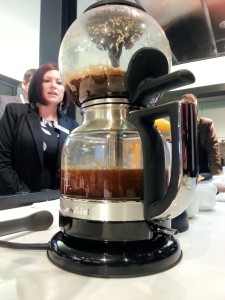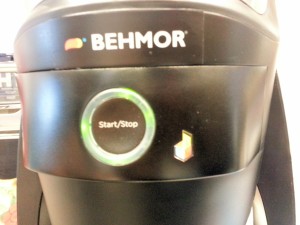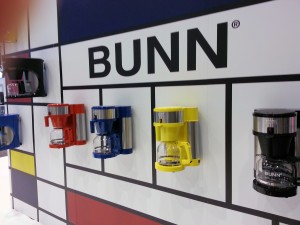by Coffee Kevin | Mar 12, 2015 |
 I keep saying that if you don’t get into coffeemakers, your coffee at home will never be great. The best trade show for the gear isn’t a coffee show at all – it’s the International Housewares Show.
I keep saying that if you don’t get into coffeemakers, your coffee at home will never be great. The best trade show for the gear isn’t a coffee show at all – it’s the International Housewares Show.
It’s where I discovered the Chemex, the Aeropress, KitchenAid’s legendary 4-cup, Bonavita, Technivorm and of course my first Bunn, the A10. Not bad for one event! They don’t really want consumers here. I get to go because I keep writing this blog and various articles. Even I used to get ignored because the sellers are always on the lookout for Macy’s buyers. Can’t blame them. I ask a hundred questions and might buy one, where department store buyers are going to buy a case for each store. It keeps me humble.
This year’s event had several new, innovative products. Let me give you a quick (by my standards) rundown. None are reviews. I sometimes look back at first-tastes and see them for the infatuations they are. I believe in long courtships regarding coffeemaker testing. 30 days is the minimum, and it reduces/eliminates new car smell, packaging, and gives me time to do old fashioned things like read the instruction book and tweak products a bit before shooting off my pen, figuratively speaking of course.
 Behmor won the Innovation Award, Kitchen Electrics, International Housewares show award for Joe Behm’s Brazen Connected 8 Cup Brew System. I was perhaps the first to review the Behmor Brazen, so you already know its leading edge position among brewers for its variable temperature setting, variable pre-infusion times (you can actually brew same-day roasted coffee without foaming overflows!) and altitude settings, which likely mean nothing to New Yorkers or Chicagoans, but are the only way to achieve SCAA-recommended brewing temperatures in Denver. Joe won his award (which kept him from showing up at CoffeeCon NYC) for the brand-new “connected” version of his brewer.
Behmor won the Innovation Award, Kitchen Electrics, International Housewares show award for Joe Behm’s Brazen Connected 8 Cup Brew System. I was perhaps the first to review the Behmor Brazen, so you already know its leading edge position among brewers for its variable temperature setting, variable pre-infusion times (you can actually brew same-day roasted coffee without foaming overflows!) and altitude settings, which likely mean nothing to New Yorkers or Chicagoans, but are the only way to achieve SCAA-recommended brewing temperatures in Denver. Joe won his award (which kept him from showing up at CoffeeCon NYC) for the brand-new “connected” version of his brewer.
With the Behmor Connected you will be able to go online and download Counter Culture’s (or other roaster’s) recommended settings for his brewer. This means even more. I can envision barista champs blogging their favorite recipes and settings for coffees ala celebrity chefs (that they really are of course) and finally being able to achieve at home exactly what they are doing in the cafes. Meanwhile, it should double Behmor’s market because more casual consumers who just care about taste, not geeky tweaking, and give them easy downloads to load.
An interesting new startup is Brewista, the brainchild of Bonavita co-owner and inventor, Brian Gross. Brian is one of the great minds of coffee brewing. He talks faster than anyone I’ve ever known, and it’s all content. He’s establishing a coffee product innovation think tank, and future manufacturing site in Cheyenne, Wyoming! He’s releasing a line of simplified Bonavita products that will feature fewer features, and lower costs to bring things like their kettles to a wider audience. Brian is working on online interconnectivity with coffeemakers, which means more sophisticated brewing and simplified operation for sleeping early-morning operators. The thing that he was most excited about was his onsite coffee shop almond milk extractors for cafes. Of course, a home version cannot be far behind. Keep an eye on Brewista. Brian has a great track record with Bonavita, and among coffee’s best overactive imaginations.
 Bunn had a wall of colorful brewers. At first I thought they’d kidnapped an Italian designer and brought them to Springfield, but it turns out they were only for display. They did have their home Trifecta on hand. I can’t help continuing to believe they should sell those in a Bose-style direct program (the pricing/profit margins are too low for mainstream retailers, even so-called high end ones like Sur La Table or Williams-Sonoma). A Connected Trifecta has to be in the works, but if it is, they’re keeping mum about it. Hope they walked the show.
Bunn had a wall of colorful brewers. At first I thought they’d kidnapped an Italian designer and brought them to Springfield, but it turns out they were only for display. They did have their home Trifecta on hand. I can’t help continuing to believe they should sell those in a Bose-style direct program (the pricing/profit margins are too low for mainstream retailers, even so-called high end ones like Sur La Table or Williams-Sonoma). A Connected Trifecta has to be in the works, but if it is, they’re keeping mum about it. Hope they walked the show.
Bunn still makes the best tasting K-cup machine I’ve yet tried. It hits the 196°F mark easily, and, used in tea (pulse) mode, does a very nice cup. iCoffee is my single nod to K-cups. I lost interest in Keurig after they released the 2.0. It has the faults of the first generation, and some new bad habits like the locking mechanism that forces you to use mediocre coffees. Too bad too, because there are some good local roasters churning out fresher, higher quality K-cups. The Keurig 2.0 is not a bad machine, in fact it is amazing for what it does, but it was designed to expand its use for many beverages, soups etcetera. It makes good (not great) coffee.
iCoffee, brainchild of Bruce Burrows, who purchased the old Remington name (they used to be a high quality coffeemaker brand). The iCoffee does extract more thoroughly than Keurig’s or most other K-cup machines. And it uses any K-cup, just as Bunn’s does, so there’s no problem filling it with the really good ones coming out. Who’s got good K-Cups? La Minita’s own brand of K-Cups, made with proprietary filters made from surgical fabric and recyclable after peeling foil, are the best I’ve yet tried. I know K-Cups are under ecological and sensory fire, but they are market reality and, as Mc Alpin and Boyd’s have proven, can be made recyclable.
KitchenAid hosted a little reviewer party one morning at their nearby (it’s not that near) showroom. I was just wowed when KA Product Development Manager Meighan McLaughlin started brewing for me with their new Siphon (vacuum) coffee maker. It has automatic cycle, a permanent filter, and has a glass top, yet features steel reinforcement at the traditionally weak points. KitchenAid also has a new grinder, with claimed burr refinement. There’s even a new KitchenAid French press which operates on AA batteries.
 I’ve saved Oxo for last. Oxo makes a lot of rubber-sided kitchen hand tools. I have their can opener, and nothing else, but it works well. So what are they doing in the coffeemaker business? Apparently, according to their charming French Senior Product Manger, Claire Ashley, they decided to enter the coffeemaking market after analyzing the current one and realizing how mediocre most coffeemakers are. Obviously, CoffeeCompanion fans know this, and also know I simply ignore most of the ones that can’t extract properly, but having searched last year for my Consumer’s Digest report, I can say that likely 80% of the ones in mainstream department stores are genetic failures in the kitchen.
I’ve saved Oxo for last. Oxo makes a lot of rubber-sided kitchen hand tools. I have their can opener, and nothing else, but it works well. So what are they doing in the coffeemaker business? Apparently, according to their charming French Senior Product Manger, Claire Ashley, they decided to enter the coffeemaking market after analyzing the current one and realizing how mediocre most coffeemakers are. Obviously, CoffeeCompanion fans know this, and also know I simply ignore most of the ones that can’t extract properly, but having searched last year for my Consumer’s Digest report, I can say that likely 80% of the ones in mainstream department stores are genetic failures in the kitchen.
Oxo first showed me their grinder; that they showed me the grinder first is a good sign. It has a built-in scale and automatic shutoff by weight. The upper beans bin is removable and sealable. If it grinds properly, (only testing can determine this) they might really have a powerful entry. They are introducing two coffeemakers. First, the 1 liter one has a glass tube so water at its hottest never touches plastic (although the grounds holder is BPA-free plastic). They have also developed algorithmic internal software that allows you to do various batch sizes and still deliver the same grounds/water contact time. This results in consistent tasting brew, whether you make two cups or eight. If it works as promised, it’s a great feature.
The second model offers a larger 12 – 4.5 oz cup batch size. According to Ms Ashley, Oxo designers recognized the heating limitations creating enough pumped hot water to do this, which she says is impossible with current technology. So, they are heating all the water at once, and then release it at approved brewing temperature. Both brewers feature tubes to release brew at carafe bottom in order to mix coffee before pouring. An unusual innovation is a transformer feature where you can remove the boiler and use it as a water kettle. Exciting!
As Sherlock Holmes, and later Carly Simon, say: These are the good old days!
by Coffee Kevin | Jan 25, 2015 |
 KitchenAid’s new 8-cup automatic drip Coffeemaker is proof that appliance manufacturers now take coffee making parameters as seriously as they do any culinary art. KitchenAid has long been a coffee innovator, with high build quality and within reasonable price points. This new model has literally been years in the making.
KitchenAid’s new 8-cup automatic drip Coffeemaker is proof that appliance manufacturers now take coffee making parameters as seriously as they do any culinary art. KitchenAid has long been a coffee innovator, with high build quality and within reasonable price points. This new model has literally been years in the making.
I visited them during summer 2012, during which time their four person design team held a therapy session, where I lay back and told them everything missing from most coffeemakers. Just kidding about that part, but suffice it to say, I left feeling unburdened and they went to work building it.
Sure enough, they brought it to this year’s CoffeeCon San Francisco and Los Angeles events. I recall making a beeline to taste a cup. It was good enough that I requested a model for my long-term at-home tests, from which I made review judgments.
This KitchenAid model has several important features:
• Pre-infusion stage. It dribbles a small amount of water, pauses to allow ultra fresh coffee grounds to get wet and exhale their carbon dioxide.
• Intermittent brewing throughout the brewing process, just like you instinctively do using a manual drip coffeemaker. We’ll talk more about this in in a moment.
• Two brewing temperatures. A higher one is just over 200°F, and optimized for lighter roasted (most Third Wave) coffees. The second, lower temperature setting stays under 200°F and is optimized for darker roast coffees. It’s up to you of course, as it’s so cutting edge that there’s hardly consensus on this subject. Suffice it to say, it’s amazing to see a big brand acknowledging the standards and then going a step further by offering you a choice of two brewing temperatures within those standards. Again, this is sophistication on par with manual brewing geeks.
• Perhaps the biggest news is that the KitchenAid meets SCAA (Specialty Coffee Association of America) brewing guidelines, which are stringent. This means a temperature spec (range: 196°-2015°F), within the given drip time spec of 4-6 minutes.
• Cup number setting. This at least promises to be an attempt to prefigure brewing algorithms so you and I don’t have to. More later, but this just might be their most important feature – if it does what it I think it promises.
First, let’s get this out of the way at the start – most so-called automatic drip brewers are one size brewers that are, by modern standards, not very automatic. If you make a full batch, they do well, maybe even very good, but most coffee enthusiasts eventually discover a manual coffee maker makes better coffee, since you have to figure out each parameter. But still, there’s a need for an automatic maker, because everyone, myself included has something else to do other than make coffee. It’s easy to operate. Just choose your cup setting. I had to get used to it, but the first thing you must do is select your desired cup batch size, but pressing plus/minus buttons. Then press whether you want light or dark roast (higher or lower brew temperature). Then hit brew and you’re ready in ten minutes, no matter what batch size.
How did it do in my tests?
Pre-infusion – The KitchenAid does really do this, but it’s still a best guess. As everyone who brews with manual drip brewers knows, this time varies depending upon how fresh your coffee is. KitchenAid designers chose a reasonable pause. It won’t please everyone, but in my tests, it did a good job of allowing most grounds to rise and fall, and then repeating this drip, pause, drip sequence throughout. Only at the 8-cup setting using extremely fresh roasted and freshly ground coffee did I get any foaming that left residue at the top of the brew basket (near showerhead). Most times it was not a problem.
Intermittent brewing – Part of the benefit of continuing to drip, pause and drip throughout the brewing is let all the water drip through before pouring more water onto the grounds. It seems to achieve a better, more thorough extraction. The KitchenAid did not disappoint. I’m sure there are some that will say their manual drip pours are better still, but for many, this brewer will deliver everything they want from their coffee.
Brewing temperature – Here KitchenAid has done itself proud. Its brewing temperature stability is as good or better than most manual drip, especially if you’re using a traditional kettle. If you’re using a kettle with settable temperature, the KitchenAid still matches or exceeds it, but the difference might be unnoticeable. Still, kudos for the two temperature choices and stability.
Cup setting – Many don’t realize that every automatic drip coffeemaker is optimized in contact time for one size batch. Larger batches will take too long, resulting in bitterness/excess strength; smaller batches mean faster (too fast) contact times and resulting weaker brew. This is simple math. If you baked a half batch of cookies and shortened or lengthened baking times, you wouldn’t expect them to taste right, would you? All drip makers, even manual ones have this challenge. KitchenAid seems to do some adjusting of the drip rate inside to accommodate the changing times, so it lessens it. I’d say they’ve make it work overall. The batches I made between four and eight cups were all between four and six minutes in overall contact time (this spec does not/should not count the time the water is heating with no contact). At the two cup setting, the contact time was not long enough. Keep in mind the cup quality may vary between 4 and 6 minutes contact time, but overall I was satisfied.
There are little tweaks you can try such as grinding a notch finer for fewer cups, or simply upping your grounds to water ratios a gram or two. I’ll leave it to others to explore these options. I settled on 6 cups for most of my tests over a month’s use and found it delivered excellent coffee at all settings between 5 and 8 cups, coffee on par overall with my manual drip brewers.
A couple of extra notations:
• The KitchenAid coffeemaker’s sound is quieter than most other automatic drip coffeemakers and its sound is subjectively nicer.
• KitchenAid is to be commended for offering detailed grounds to cup measuring recipes in their well-written instruction book.
• The water input at the KitchenAid’s top is too narrow for my tastes. I occasionally spilled water while filling it. Maybe it’s just me.
• I routinely filled the water tank exactly to the intended batch cups mark, and found the resulting brew on the carafe at brewing’s end was frequently less. I realize this may be caused by steam loss, but I found it works better to always overfill above the water mark.
Here are a few taste test highlights: I was fortunate to pick up a sample of Martin Diedrich’s Kean Coffee at CoffeeCon L.A. It was a slightly darker roast than most Third Wave roasts, and, (gasp) in my opinion, the better for it. It really shined, especially with using the lower (but still SCAA-approved) temperature setting. This kind of coffee really has that chocolate taste (cliché though it seems) and that temperature just seemed to highlight it.
Another treat was Counter Culture’s latest Ethoipian in a new package. This one really called for the higher temperature, but fully matched my expectations, with a fruitiness and acidity this coffee brewer brought forth in all its glory.
A surprise hit of CoffeeCon LA’s roasts was Temple Coffee’s Panama Geisha. Oh my Lord! What a coffee!! I did two batches concurrently. It was so good I went past my limit. The high temperature was my preference, but it did splendidly (albeit differently) in each. Note: I found a perfect formula for me was to make six cups, using 50 weighed grams of beans, medium-fine grind. The slightly less than full batch allowed even the freshest coffees to brew properly, and gave us a perfect way for Pat, I and a friend each have a couple of cups each.
The KitchenAid 8-cup is highly recommended.
 I keep saying that if you don’t get into coffeemakers, your coffee at home will never be great. The best trade show for the gear isn’t a coffee show at all – it’s the International Housewares Show.
I keep saying that if you don’t get into coffeemakers, your coffee at home will never be great. The best trade show for the gear isn’t a coffee show at all – it’s the International Housewares Show. Behmor won the Innovation Award, Kitchen Electrics, International Housewares show award for Joe Behm’s Brazen Connected 8 Cup Brew System. I was perhaps the first to review the Behmor Brazen, so you already know its leading edge position among brewers for its variable temperature setting, variable pre-infusion times (you can actually brew same-day roasted coffee without foaming overflows!) and altitude settings, which likely mean nothing to New Yorkers or Chicagoans, but are the only way to achieve SCAA-recommended brewing temperatures in Denver. Joe won his award (which kept him from showing up at CoffeeCon NYC) for the brand-new “connected” version of his brewer.
Behmor won the Innovation Award, Kitchen Electrics, International Housewares show award for Joe Behm’s Brazen Connected 8 Cup Brew System. I was perhaps the first to review the Behmor Brazen, so you already know its leading edge position among brewers for its variable temperature setting, variable pre-infusion times (you can actually brew same-day roasted coffee without foaming overflows!) and altitude settings, which likely mean nothing to New Yorkers or Chicagoans, but are the only way to achieve SCAA-recommended brewing temperatures in Denver. Joe won his award (which kept him from showing up at CoffeeCon NYC) for the brand-new “connected” version of his brewer. Bunn had a wall of colorful brewers. At first I thought they’d kidnapped an Italian designer and brought them to Springfield, but it turns out they were only for display. They did have their home Trifecta on hand. I can’t help continuing to believe they should sell those in a Bose-style direct program (the pricing/profit margins are too low for mainstream retailers, even so-called high end ones like Sur La Table or Williams-Sonoma). A Connected Trifecta has to be in the works, but if it is, they’re keeping mum about it. Hope they walked the show.
Bunn had a wall of colorful brewers. At first I thought they’d kidnapped an Italian designer and brought them to Springfield, but it turns out they were only for display. They did have their home Trifecta on hand. I can’t help continuing to believe they should sell those in a Bose-style direct program (the pricing/profit margins are too low for mainstream retailers, even so-called high end ones like Sur La Table or Williams-Sonoma). A Connected Trifecta has to be in the works, but if it is, they’re keeping mum about it. Hope they walked the show. I’ve saved Oxo for last. Oxo makes a lot of rubber-sided kitchen hand tools. I have their can opener, and nothing else, but it works well. So what are they doing in the coffeemaker business? Apparently, according to their charming French Senior Product Manger, Claire Ashley, they decided to enter the coffeemaking market after analyzing the current one and realizing how mediocre most coffeemakers are. Obviously, CoffeeCompanion fans know this, and also know I simply ignore most of the ones that can’t extract properly, but having searched last year for my Consumer’s Digest report, I can say that likely 80% of the ones in mainstream department stores are genetic failures in the kitchen.
I’ve saved Oxo for last. Oxo makes a lot of rubber-sided kitchen hand tools. I have their can opener, and nothing else, but it works well. So what are they doing in the coffeemaker business? Apparently, according to their charming French Senior Product Manger, Claire Ashley, they decided to enter the coffeemaking market after analyzing the current one and realizing how mediocre most coffeemakers are. Obviously, CoffeeCompanion fans know this, and also know I simply ignore most of the ones that can’t extract properly, but having searched last year for my Consumer’s Digest report, I can say that likely 80% of the ones in mainstream department stores are genetic failures in the kitchen.

